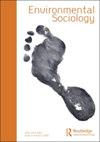Locking-in white-nose syndrome? The limits of the endangered species act & non-charismatic megafauna
IF 2.8
Q3 ENVIRONMENTAL STUDIES
引用次数: 0
Abstract
ABSTRACTWhite-nose syndrome is a deadly pathogenic fungus that has killed millions of bats. In this article, we ask why, despite a well-coordinated response and a relatively steady federal funding stream, WNS has continued to spread with lethal results? To answer this question, we bring together the tools of political ecologists studying health and diseases with social scientific observations on the impacts of lock-ins on social change. We argue that while federal legislation such as the Endangered Species Act (ESA) allowed researchers to quickly recognize the emergence of WNS, the ESA’s focus and directives to protect individual species constrained the ability of scientists to more rapidly understand both the fungus causing WNS and the broader ecosystem dynamics in which the disease can flourish. In addition, while the ESA was written to protect endangered species regardless of their public perception or perceived economic value, such dynamics influence what gets classified as endangered and how much funding a species receives for protection. We thus further argue that the anthropocentric nature of policy making has made it difficult to address WNS and other wildlife diseases with less obvious human impacts in a more holistic way.KEYWORDS: White-nose syndromeendangered species actpolitical ecologylock-ins AcknowledgmentsThe authors would like to thank Amy A. Quark and the studies’ participants who took the time out of their schedules to read over earlier drafts of the manuscript. All errors and claims are of course the responsibility of the authors.Disclosure statementNo potential conflict of interest was reported by the author(s).Notes1. When first discovered, the fungus was scientifically referred to as Geomyces destructans.2. We recognize that justifying the focus of this manuscript on the economic importance and value of bats is a bit ironic. As many of our informants noted, bats have intrinsic value and are distinctly unique mammals. However, given the anthropocentric nature of the discipline of sociology, we highlight their value to human populations here.3. Bats in Europe are thought to have evolved a resistance to P. destructans and do not suffer from WNS even when the fungus is present on their bodies or in their caves (Blehert et al. Citation2009).Additional informationFundingThe research for this paper was funded by the William & Mary Environment & Sustainability Program Undergraduate Summer Research Fellowship.Notes on contributorsJordan HadlockJordan Hadlock is a student in Department of Sociology and the Environment & Sustainability Program at William & Mary. They have future career and research aspirations in conservation and social and environmental justice.Brent Z. KaupBrent Z. Kaup is a Professor of Sociology at William & Mary. His research focuses on the links between finance, landscape change, and infectious disease.白鼻闭锁综合症?《濒危物种法》的限制non-charismatic巨型动物
摘要白鼻综合征是一种致命的致病真菌,已经杀死了数百万只蝙蝠。在这篇文章中,我们要问的是,尽管有协调良好的应对措施和相对稳定的联邦资金流,WNS仍然继续传播并造成致命的后果。为了回答这个问题,我们将政治生态学家研究健康和疾病的工具与锁定对社会变革影响的社会科学观察结合起来。我们认为,尽管《濒危物种法》(ESA)等联邦立法允许研究人员迅速认识到WNS的出现,但ESA对保护单个物种的关注和指令限制了科学家更快地了解引起WNS的真菌和疾病可能蓬勃发展的更广泛的生态系统动态的能力。此外,尽管ESA是为了保护濒危物种而编写的,不管它们的公众看法或感知的经济价值如何,但这种动态影响了哪些物种被列为濒危物种,以及一个物种获得多少保护资金。因此,我们进一步认为,政策制定的人类中心主义性质使得难以以更全面的方式解决WNS和其他人类影响不太明显的野生动物疾病。关键词:白鼻综合征;濒危物种;政治生态锁定;致谢作者要感谢Amy A. Quark和研究参与者在他们的时间表之外花时间阅读了手稿的早期草稿。所有的错误和主张当然是作者的责任。披露声明作者未报告潜在的利益冲突。当这种真菌第一次被发现时,科学上称其为破坏地菌。我们认识到,将这份手稿的重点放在蝙蝠的经济重要性和价值上是有点讽刺的。正如我们的许多线人所指出的那样,蝙蝠具有内在价值,是一种独特的哺乳动物。然而,鉴于社会学学科的人类中心主义性质,我们在这里强调它们对人类人口的价值。欧洲的蝙蝠被认为已经进化出了对破坏假单胞菌的抵抗力,即使真菌存在于它们的身体或洞穴中,也不会患WNS (Blehert等人)。Citation2009)。本论文的研究由William & Mary环境与可持续发展项目本科生暑期研究奖学金资助。作者jordan Hadlock是威廉玛丽学院社会学系和环境与可持续发展项目的学生。他们未来的职业和研究目标是保护和社会与环境正义。布伦特·z·考普是威廉玛丽大学的社会学教授。他的研究重点是金融、景观变化和传染病之间的联系。
本文章由计算机程序翻译,如有差异,请以英文原文为准。
求助全文
约1分钟内获得全文
求助全文
来源期刊

Environmental Sociology
ENVIRONMENTAL STUDIES-
CiteScore
4.60
自引率
12.00%
发文量
34
期刊介绍:
Environmental Sociology is dedicated to applying and advancing the sociological imagination in relation to a wide variety of environmental challenges, controversies and issues, at every level from the global to local, from ‘world culture’ to diverse local perspectives. As an international, peer-reviewed scholarly journal, Environmental Sociology aims to stretch the conceptual and theoretical boundaries of both environmental and mainstream sociology, to highlight the relevance of sociological research for environmental policy and management, to disseminate the results of sociological research, and to engage in productive dialogue and debate with other disciplines in the social, natural and ecological sciences. Contributions may utilize a variety of theoretical orientations including, but not restricted to: critical theory, cultural sociology, ecofeminism, ecological modernization, environmental justice, organizational sociology, political ecology, political economy, post-colonial studies, risk theory, social psychology, science and technology studies, globalization, world-systems analysis, and so on. Cross- and transdisciplinary contributions are welcome where they demonstrate a novel attempt to understand social-ecological relationships in a manner that engages with the core concerns of sociology in social relationships, institutions, practices and processes. All methodological approaches in the environmental social sciences – qualitative, quantitative, integrative, spatial, policy analysis, etc. – are welcomed. Environmental Sociology welcomes high-quality submissions from scholars around the world.
 求助内容:
求助内容: 应助结果提醒方式:
应助结果提醒方式:


